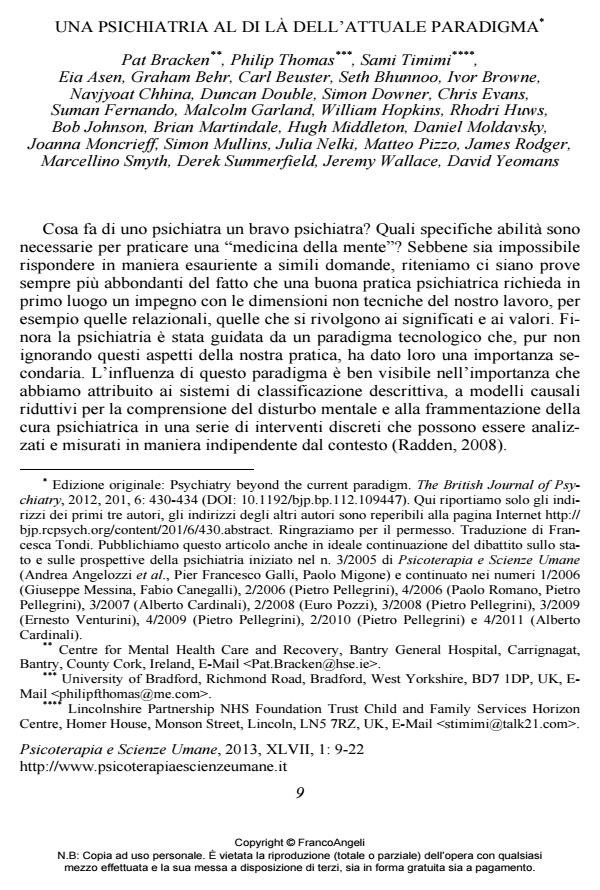Psychiatry beyond the current paradigm
Journal title PSICOTERAPIA E SCIENZE UMANE
Author/s Pat Bracken, Philip Thomas, Sami Timimi, Eia Asen, Graham Behr, Carl Beuster, Seth Bhunnoo, Ivor Browne, Navjyoat Chhina, Duncan Double, Simon Downer, Chris Evans, Suman Fernando, Malcolm Garland, William Hopkins, Rhodri Huws, Bob Johnson, Brian Martindale, Hugh Middleton, Daniel Moldavsky, Joanna Moncrieff, Simon Mullins
Publishing Year 2013 Issue 2013/1
Language Italian Pages 14 P. 9-22 File size 95 KB
DOI 10.3280/PU2013-001002
DOI is like a bar code for intellectual property: to have more infomation
click here
Below, you can see the article first page
If you want to buy this article in PDF format, you can do it, following the instructions to buy download credits

FrancoAngeli is member of Publishers International Linking Association, Inc (PILA), a not-for-profit association which run the CrossRef service enabling links to and from online scholarly content.
A series of recent editorials in The BritishJournal of Psychiatry have argued that psychiatry is in the midst of a crisis. The varioussolutions proposed would all involve a strengthening of psychiatry’s identity as essentially "appliedneuroscience". While not discounting the importance of the brain sciences and psychopharmacology,the Authors argue that psychiatry needs to move beyond the dominance ofthe current, technological paradigm. This would be more in keeping with the evidence abouthow positive outcomes are achieved and could also serve to foster more meaningful collaborationwith the growing service-user movement. Various controlled studies supporting the efficacyof non specific and non technological interventions are reviewed.
Keywords: Technologicalparadigm in psychiatry, non-specific interventions, therapeutic relationship, evidencebasedpsychiatry, service-user movement in psychiatry
- Le due facce della psichiatria Paolo Migone, in RIVISTA SPERIMENTALE DI FRENIATRIA 2/2015 pp.49
DOI: 10.3280/RSF2015-002006 - Il processo diagnostico e relazionale in psichiatria. Validità epistemologica tra normalità e patologia Alfio Allò, in Ricerca Psicoanalitica /2021
DOI: 10.4081/rp.2021.277 - Processi archetipici nella formazione di un sogno e di un delirio: un contributo clinico Paolo Romano, in STUDI JUNGHIANI 39/2014 pp.37
DOI: 10.3280/JUN2014-039003
Pat Bracken, Philip Thomas, Sami Timimi, Eia Asen, Graham Behr, Carl Beuster, Seth Bhunnoo, Ivor Browne, Navjyoat Chhina, Duncan Double, Simon Downer, Chris Evans, Suman Fernando, Malcolm Garland, William Hopkins, Rhodri Huws, Bob Johnson, Brian Martindale, Hugh Middleton, Daniel Moldavsky, Joanna Moncrieff, Simon Mullins, Una psichiatria al di là dell’attuale paradigma in "PSICOTERAPIA E SCIENZE UMANE" 1/2013, pp 9-22, DOI: 10.3280/PU2013-001002